Here comes a final part of the list of things that fascinated me in Japan. This part will collect aspects of life that at least remotely relate to traditions. Writing about any kind of traditions is a slippery path: you either need to be very qualified in this topic, or at least sure in interpretations of what you have seen and felt. As a tourist I am neither first, nor the second, but below are thoughts and statements describing my personal experience.
Due to its isolated historical development, Japan undoubtedly has established very rich and distinctive culture, that is heavily relying on rituals and subordination. Moreover, it still successfully holds in modern society under current globalization pressure, offering unique experience for a foreigner.
I was always intrigued by the level of formality in Japanese society. On the one hand, it might seem overly complicated, but once clear, it makes one’s life so much easier and better structured on various levels of daily communication. We were quite lucky to get in touch with this side of life on numerous occasions.
In the previous parts I discussed in detail food and cuisine: items 1 to 10; and modern side of Japan: items 11 to 22. In this part:
- Residential districts
- Speaking Japanese with locals
- Gardens and parks
- Tea Ceremony
- Sword practice
- Japanese cuisine theory and practice
- Ryokan
- Onsen
- Kimono experience
- People-watching
- Shopping streets and arcades
23. RESIDENTIAL DISTRICTS OF TOKYO
Getting off the main streets full of tourists can offer a nice change of pace, while providing an opportunity to feel the vibe of the city that locals live in. We have been exploring residential neighborhoods both with guides and by ourselves and those walks never ceased to deliver unique impressions.

As for me, there is a distinctive feature to residential districts of Tokyo that especially gets me. It is a density of a build-up area. In fact, we have also lived deep in the residential area in Kyoto and might as well put it on a list, but Tokyo districts are so tightly packed, with every inch of space utilized with maximum efficiency, that it feels completely different. Views of residential neighborhoods are the essential part of modern Japanese visual arts. You can instantly recognize a specific architecture decorated with a tangled mess of electric wires. The lack of space creates a situation, where the boundary between a private and a common area is very shallow, yet so clear. Also, what did strike me the most, was the comfortable coexistence side-by-side of old and new. Ultimate eclecticism both in architecture and visual appearance of residents, that is the core of modern Japan for me.
We have asked one of our guides: if there is any particular place in Tokyo that he enjoys showing to tourists and he named Yanaka district. By that time we have already visited it with another guide and we could instantly understand what he meant. Hope, image conveys at least the smallest bit of my feelings =)
24. SPEAKING JAPANESE
Visiting a country as remote as Japan was challenging for us not so much geographically, but culturally. It was a new frontier to me personally, so I have made an extra preparation effort and spent some time in a company of Japanese language textbook and workbook =) Online language exchange app was also a great help not only in speaking/listening/writing practice, but also in understanding a mindset of people. All in all that was interesting period full of discoveries, that peaked during the trip itself =). A disclaimer is in order here: despite the heading, it wasn’t “speaking” per se, however my humble couple of sentences helped me to find common tongue with locals in various situations. Whether it is a random conversation in onsen (yes, locals actually tend to have a small-talk with you there), or a price negotiation in a store, doing a little step towards your interlocutor make them do two steps towards you in response.
The possible “trap”, that haunts the beginner is the difference between keigo (敬語) and informal language. A tourist constantly hears different forms of keigo while interacting with customer service representatives. However, knowing what form of response is required in any particular social situation is some kind of wizardry that I haven’t mastered so far. Which never stopped me from doing my best and maybe even confusing my companions in several occasions.
All pragmatic aspects aside, I just genuinely love the way Japanese language sounds =)
25. GARDENS AND PARKS
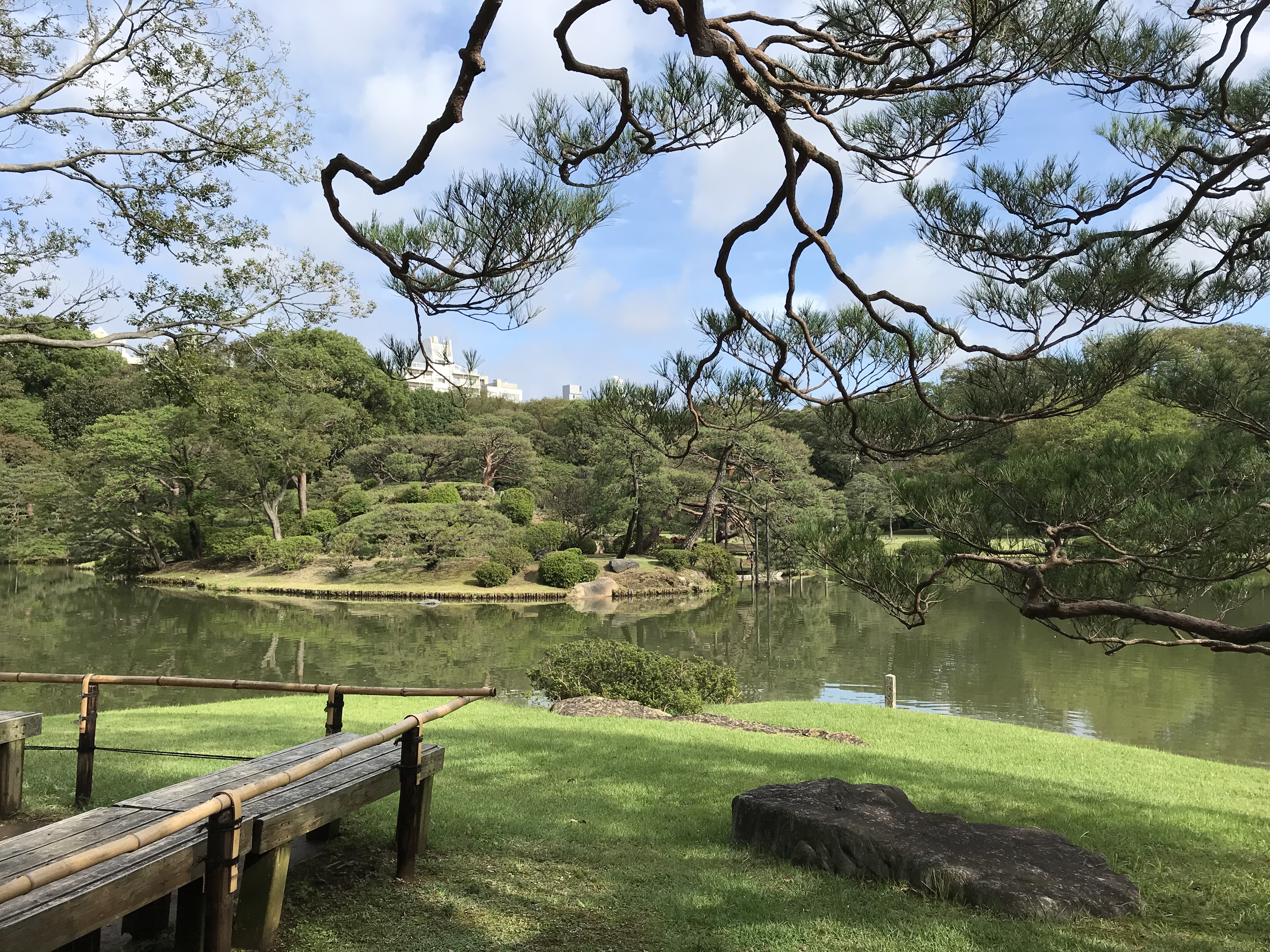
With this one I most likely tested the limits of Ilya’s patience. I just couldn’t get enough of visiting different parks and gardens, However those easily may seem all the same to somebody, so I can see how it can get boring after the fourth one =) I genuinely enjoy an instant transition of atmosphere once you are entering the garden’s gate. High walls block all the noise of the surrounding metropolis and you can switch off your head entirely, just taking a relaxing stroll or having a cup of green tea in a tea house.
Here comes a brief short list of the parks that I especially liked in Tokyo. By far this list is not complete, as there are still so many places we didn’t visit. But you have to start somewhere, right?
RIKUGIEN GARDEN
Small and lovely, Rikugien Garden offers an opportunity to see everything that is inherent to traditional public garden and won’t make you too tired walking around =) Located inside a residential area, visit to this park combines well with a stroll around quiet neighborhood. Rikugien Garden is high in top lists of the most beautiful gardens of Tokyo and deservedly so.
Address: 6 Chome-16-3 Honkomagome, Bunkyō, Tokyo 113-0021, Japan
HAMARIKYU GARDENS
Surrounded by water from all 4 sides, Hamarikyu is stunningly beautiful in landscapes and rich in history. Skyscrapers rising over the tree crowns on a sunny day are very spectacular. It is relatively large, so getting to every single pin on the map might require some time, but in my opinion they’re uniform in style, so you can organize your itinerary based on your interests. The park is might be quite lively in a clear and warm day, when local “salarymen” come during the lunch breaks, but fear not, it is spacious enough to accommodate all visitors and still keep the feeling of privacy.
Moreover, it has the nicest teahouse Nakajima no Ochaya located in the middle of a pond.
Address: 1-1 Hamarikyuteien, Chuo, Tokyo 104-0046, Japan
SHINJUKU GYOEN NATIONAL GARDEN
Uniform style is not the case with this one. Behind the garden walls several different parks coexist. As we were pursuing the specific purpose there, we skipped western style parts and concentrated on Japanese-style garden. The best part about this park, is that it is even more impressive in the rain. Deep glossy green colors of a wet foliage is a view not to be missed. If you have seen and liked “The Garden of Words” (言の葉の庭), no more words necessary, just come!
Address: 11 Naitomachi, Shinjuku, Tokyo 160-0014, Japan
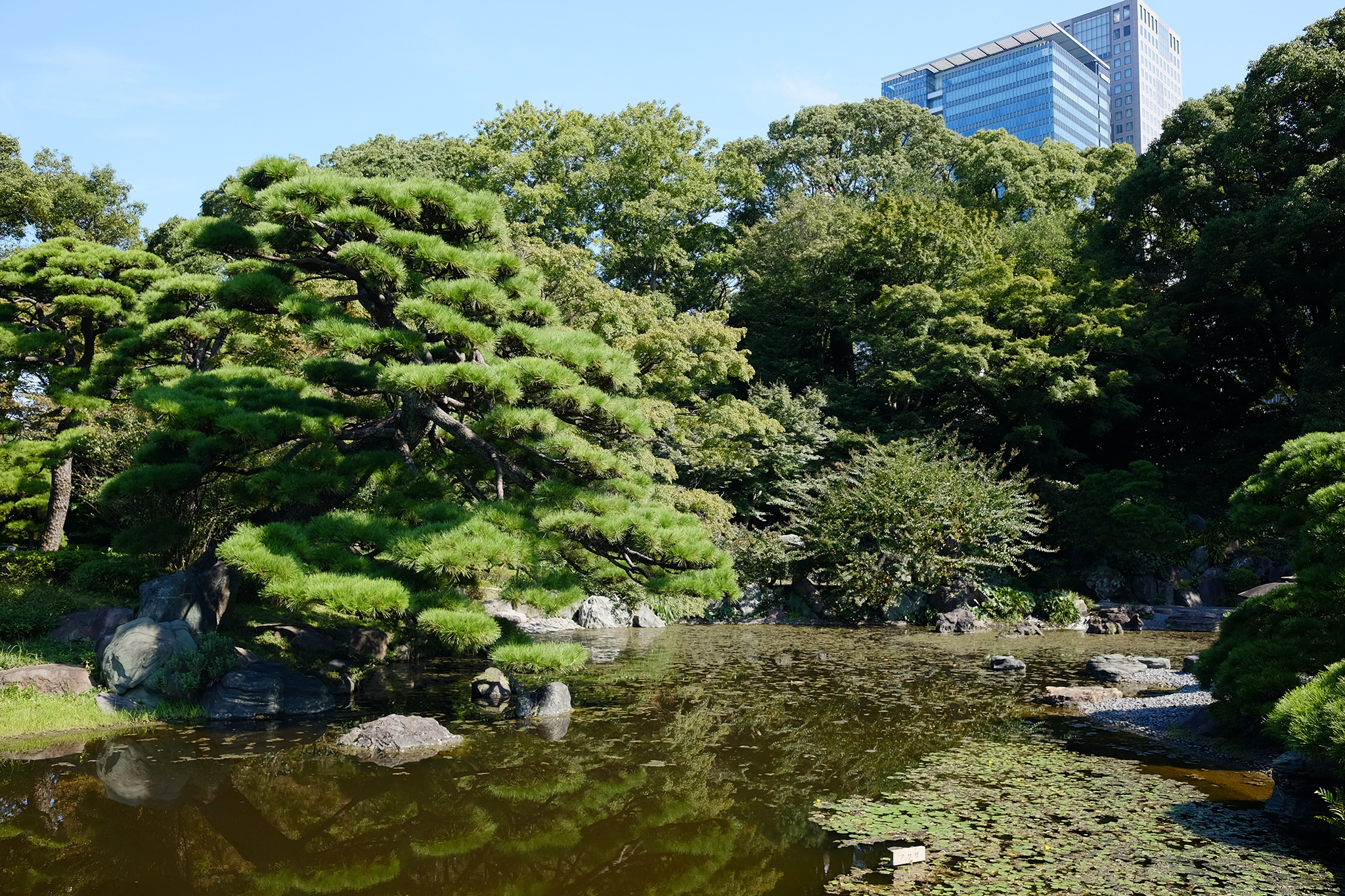
26. TEA CEREMONY
I have a notion, that for tourist there are two main levels of involvement in tea ceremony. First, observe and admire and second is interaction, where instructor explains the rituals of tea ceremony and the meaning behind each action of participants. We were lucky to take part in a second one =)
The essence of it is too complicated to fully convey and/or comprehend in one sitting, but it is definitely educational in terms of understanding general structure and some some intricacies of social interactions. Also, it teaches you to consciously admire the object in front of you, whether it is a tea bowl (mindfully selected by host for each guest) or the pattern of a tea foam left on the bottom of the bowl after the last sip.
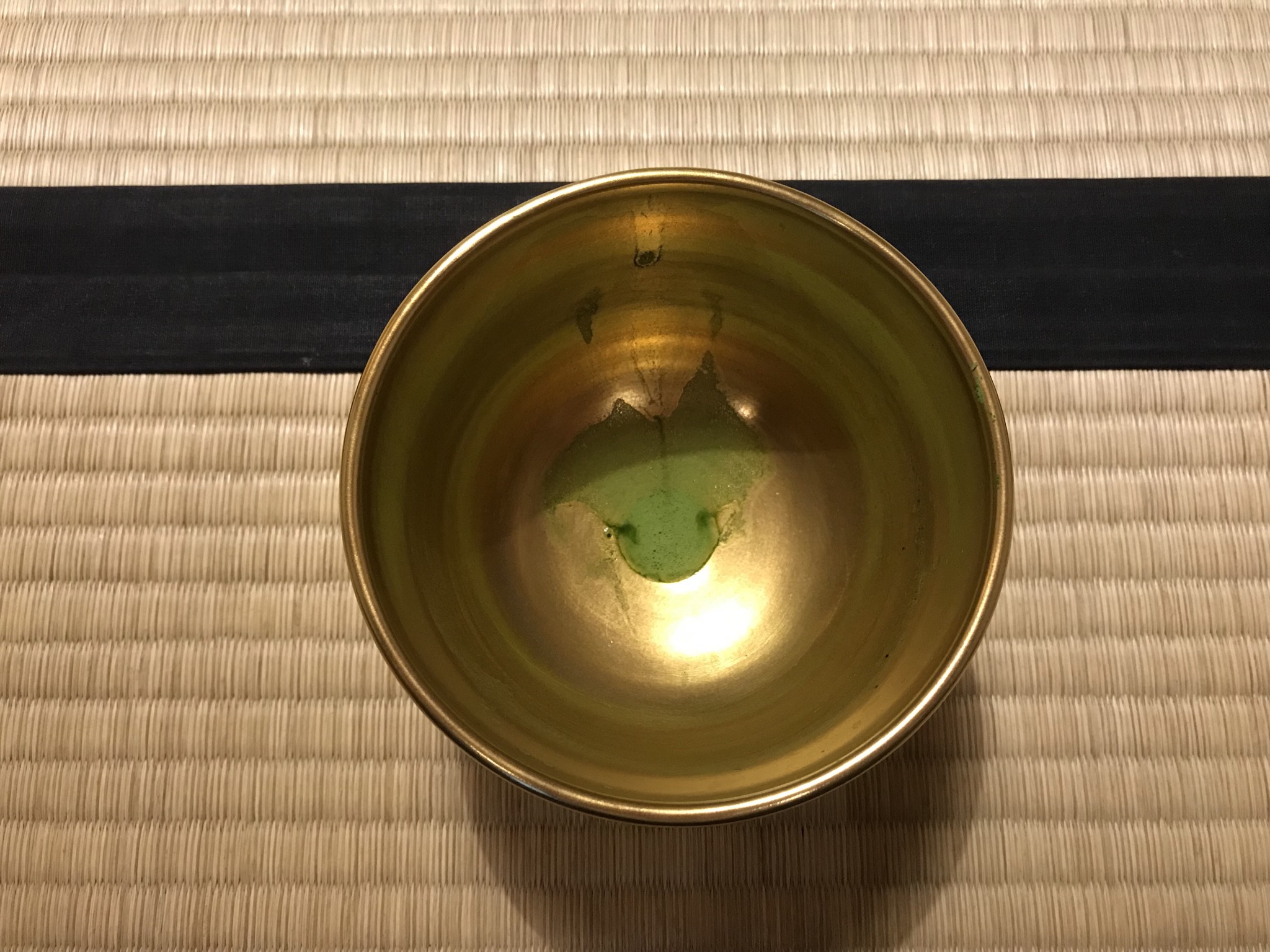
Besides, it was the hardest experience of sitting seiza I had in Japan. During all other occasions there was an opportunity to adjust, hiding behind the table, when alone etc. But here you are exposed to your companions at all times. My suggestion, if you do not think you can manage it, do not even start =) Fidgeting on a tatami during the ritual might be more distracting than random comfortable sitting pose.
27. SWORD PRACTICE
I hope, Ilya will get into more detail on this experience, but I just cannot omit it. Chosen as a pure “tourist attraction”, this meeting with sensei turned up to be so much more for us. We have got to swing daito bokken training swords amply and I have had an opportunity to legitimately hit my husband with a wooden stick =) What else do you need? In addition we were taught to put on kimono and hakama and properly walk like a real samurai. I even had a leading role in a “jidaigeki” short film, where I bravely fight off treacherous enemies, who dare to attack me =). It was one of the Airbnb experiences that we booked. With all other receiving parties, I am comfortable calling them the hosts, but with Ooshiro-san, the “sensei”, is the only appropriate way to call him. The knowledge of etiquette that we got from his short lesson earned us a couple of grateful smiles later on the trip.

28. JAPANESE CUISINE THEORY AND PRACTICE
I have mentioned it numerous times over the course of these article series, but I just love participate in cooking classes. Mainly because i like the feeling of cooking together with other people, but even more so, because it teaches me new things. And by new things I mean not only recipes, but the theory behind the cuisine basics.
Modern Japanese home-cooking successfully interconnect the comfort of store bought pre-made ingredients with cooking philosophy that is centuries old. It is somewhat similar to Japanese notion of religion: they take over concepts and recipes from around the world, but adopt it to local cultural framework, totally transforming it and making their own as they go.

Philosophy of five elements on the plate, same basic ingredients turning up to give different tastes in a cooking process, there are so many concepts to comprehend and so many nuances, that are just impossible to learn with one or two cooking classes.
Getting to everyday practice, I cannot say that we embraced Japanese cuisine in our day to day life, but we clearly broadened our kitchen boundaries with rice-cooker that is now used regularly =) We still nurture the idea of home-cooked tonkotsu ramen, though it will probably not happen in foreseeable future.
29. RYOKAN
In short, ryokan is a Japanese traditional style inn with tatami floor, sliding doors, futon beds and all the related delights. No wonder, we wanted to experience that! However, proper ryokan stay can be pricey. This is the fact you learn first thing on travel-themed websites. So we gave this idea a considerable thought, swinging between “Yeah, we must definitely go while we are at it!” and “Nah, let’s splurge on something more tangible”. I am glad that we not only decided for the “go” option, but also decided to find the most authentic experience available. That included:
-
Remote location. There are tons of ryokan-style accommodations available in all cities we stayed in, but we fancied the idea to combine the ryokan stay with a opportunity to explore smaller towns. Nevertheless, we were still considering areas that were relatively easy to access by public transport. Yugawara seemed like a nice pick, as it is located along the Tokaido Main line, far enough from Tokyo (outskirts of Kanagawa prefecture), basically same mountain range as Hakone area, but no Mt. Fuji view, that guaranteed eager fellow tourists will be staying elsewhere.
-
Old building. It is easy to find ryokan that looks like a generic hotel from outside, but has the traditional interior on the inside. But that wasn’t what we were looking for. We wanted old and squeaky building with history rather just plain tatami floor room.
-
Family-owned establishment with history. In any part of the world personal touch gives an extra swing to a business. In Japan especially so. Deep-rooted traditions of the ryokan that would provide us with a level of required behavior to live up to, as opposed to the hotel getting down to foreigners’ level in order to attract customers.
Our choice was Kamata ryokan in Yugawara. We are extremely grateful to Kamata Ruriko-san and her staff for making our stay so special.
A word of advice, if you plan to explore the surroundings while staying in ryokan, you should book more than one night stay. One night is barely enough to explore the facilities and services of a ryokan itself: kaiseki style dinner and breakfast alone will take up to four hours of your time.
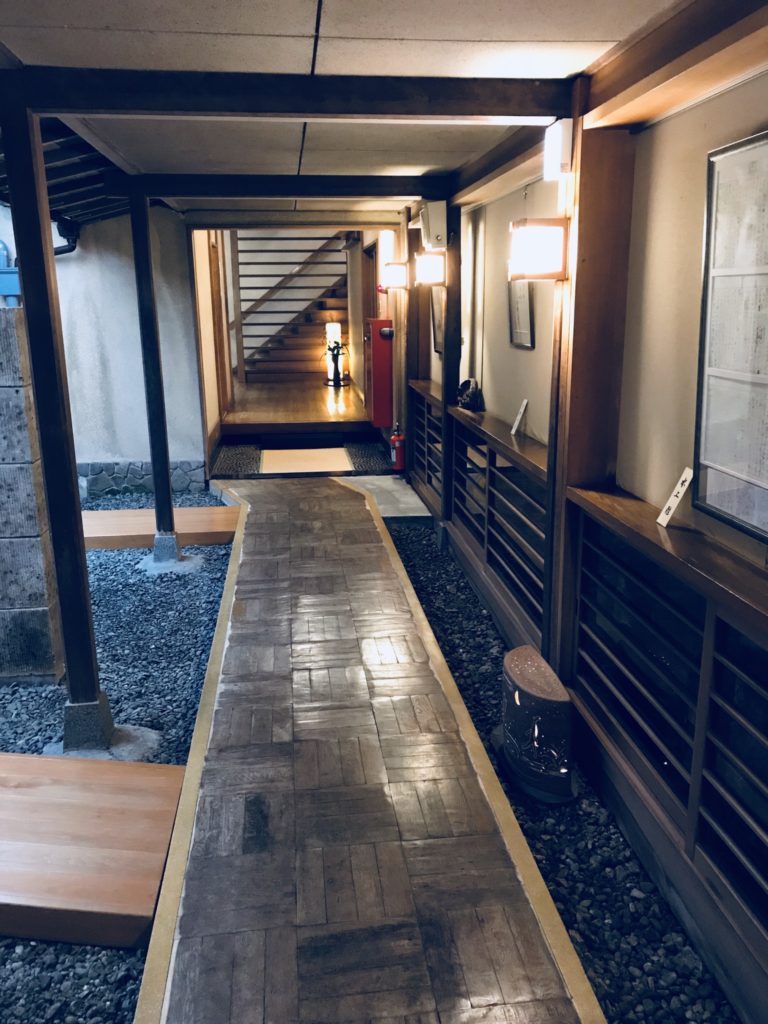
30. ONSEN
Onsen (hot spring bath) was a part of a ryokan experience for us. However, it can also be enjoyed separately. Which is financially reasonable idea, I would say =)
Due to a geographical position various regions of Japan can offer onsen with water from natural hot springs. The chemical composition of this watercan be high in sulphur, salt (sodium chloride), iron, etc. Every mineral is allegedly good for your health in one way or another. Depending on your location the composition of water will change, but it is barely a deciding factor in case of one time visit.
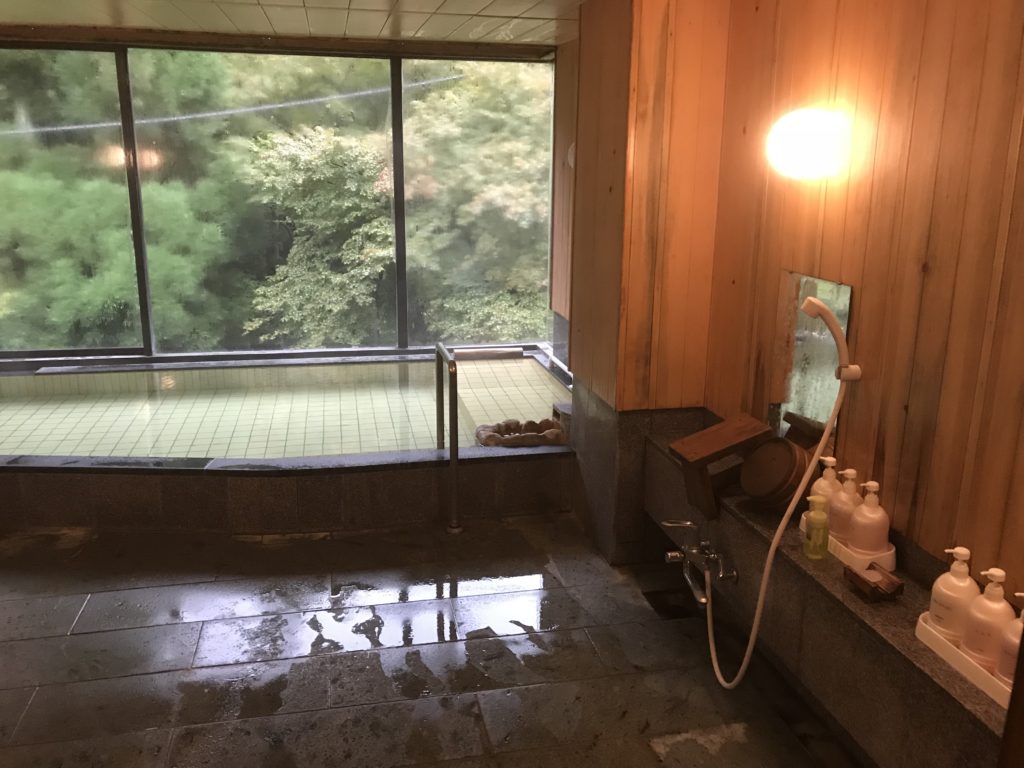
When considering a visit to onsen, bear in mind rather strict rules of conduct in there. Google it beforehand and do not hesitate to double check with staff, to avoid confusion. Nakedness, modesty towel, soap and a million more details that can put you, or others around you in rather uncomfortable situation. And yes, as mentioned before, other visitors do tend to converse with you while relaxing in the bath, so be open-minded about it =)
If you are as lucky as we were, you get to use private rotenburo (open air hot bath). A typical common onsen is separated by gender, while private bath allows you to share the experience with your travel companions. Open-air bath is an experience on it’s own. Rainy October afternoon with steaming water around you and glossy rich-green foliage at arm’s length, it just doesn’t get any better!
31. KIMONO EXPERIENCE
Going for kimono rental in a touristy district was a risky bid for me. I knew I would stand out from the crowd even among the other kimono wearers and attract attention. Nevertheless, the temptation was too big to miss it. As a result, I was pretty much the only tall blonde in traditional wear in the vicinity of Kiyomizu-dera, Kyoto that noon. It did not stop our couple from peeking into all the little souvenir shops and climbing all the stairs though, drawing tons of attention.
In ryokan you get to wear yukata, cotton kimono, that is waaay easier to put on than the full kimono apparel. Still there are several tips and tricks that you should know before putting any kind of kimono on. First and foremost being: you wrap left side of kimono over right! Also tying a nice obi knot requires some skill, but with youtube tutorials and a little practice, you will be able to do it in no time.

So, back to full kimono (as on the image above). I have at least five layers of garments on me, starting from several undershirts, lower skirt and tons of terrycloth towels wrapped around my waist to make my shape traditional. With kimono rental service the attendant dresses you and, honestly, no way I could repeat the procedure or the technique myself =)
Kimono rentals all over the Japan serve the purpose of promoting the kimono wearing among population. In this regard, we think, we managed to contribute to this great cause. School kids and random tourists asked to take pictures of us and with us, I got my fair share of “oh-so-tall lady” comments from locals, and Mr. just rocked the traditional look like a pro =)
32. PEOPLE-WATCHING

Enough with traditional wear, let’s talk everyday clothes. This one is my girly thing. Besides, I was on a “mission” to observe and report back home on “how ladies of different age groups dress there”. During the entire travel I tried to keep an eye on an overall picture on the public space. In my opinion, the tendency towards uniforming everything plays nicely at the society’s hand. At the moment in Tallinn, it is the grayest possible time of the year and lack of color tends to be depressive. In Japan, in a train car full of schoolkids and office workers you do not find that much color either, but in latter case in seems somewhat appropriate and neat. It seemed to me that women and men both tend to neutral colors (black, white, gray, beige) playing on the contrast to make the outfit stand out. Also, layering is definitely a theme there. The most prominent feature for me was the fact that even with +29° outdoors, the absolute majority of ladies would have their arms and legs covered for at least 3/4. Oh man, did I get the looks for my exposed legs above knee from numerous ageless 40+ ladies! If you are even just a little bit self-conscious, pack an extra light and long clothing options for a hot weather, it might come handy. =) All right, it is not like, they are all good, and I was all bad, here and there on the streets you could meet a lady sporting a hideous velvet tracksuit, but these occasions were so rare that I remember them all (purple, yes; and oh-my-god golden one).
Long story short: don’t let anybody distract you from your own style, but be mindful of a foreign cultural space. And if you are a fortunate person who fits into Japanese grid of garment sizes, then you are in luck! Just reserve some luggage space for the shopping frenzy.
33. NISHIKI MARKET, KAPPABASHI SHOPPING STREET, SUGAMO DISTRICT AND OTHER SHOPPING ARCADES
When I get to a proper market area, I feel a lot like a child in a candy store. I instantly need everything I can lay my eye on. Places that offer a street food are “the worst”, I am so stuffed by the first third of the journey between the carts and counters, that I am unable to “ingest” any further goodness of the place. Still I enjoyed visiting shopping areas around Japan a lot.
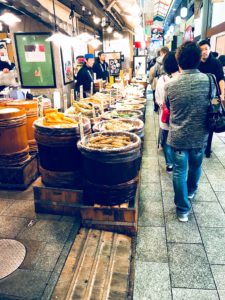
Nishiki market in Kyoto offers a wide variety of local edibles of all sorts. Upbeat lively tempo of people moving around you feels nice, but doesn’t discourage you from taking a closer look to things that catch your eye.
Kappabashi shopping street is a totally different story. It has a very specific focus on kitchenware and is oriented mostly to wholesale. But fear not! In a pursuit of unique dishware of traditional cooking utensils, there is no better place to go. The only thing that kept me from buying all them nice bowls and dishes was a weight and volume limit on our luggage =)
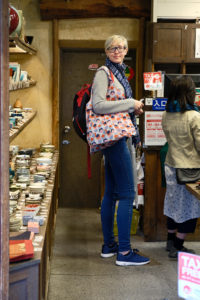
Sugamo shopping district in Tokyo is often called “Harajuku for elderly”. While everybody seem to love Harajuku, there is on distinctive advantage of Sugamo: the relaxed flow and chilled atmosphere. Locals do actually shop there, so you do not feel like a tourist in a sightseeing spot. You just roll from shop to shop in your own pace. Not mentioning the souvenir shopping and local specialty food tasting, that comes with it. I had my first “meaningful” conversation in Japanese in Sugamo, with dango seller =)
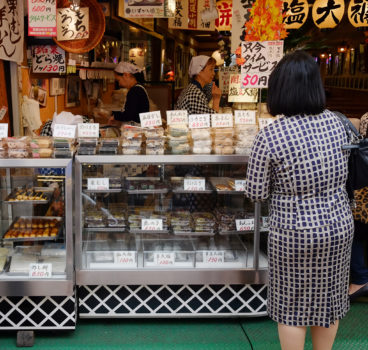
Shopping arcades of Osaka made our stay pleasant despite a Typhoon Lan. Roofed walkways made a weather mostly irrelevant =) Shinsaibashisuji shotengai caters to the needs of every tourist, with shops ranging from world-famous brand stores to local specialty shops. And herein lies it’s shortcoming: extremely touristy and always crowded. As an alternative, go for Tenjinbashisuji shopping arcade. Again, it is mostly local-oriented, has more authentic “flavor” and if you are not afraid of peeking into the back-alleys, you can end up eating best okonomiyaki in Osaka (kudos to our guide Hirokazu-san for feeling our exact needs on that).
I could go on and about on this subject, but you got the general idea, right? I recommend visiting different shopping areas, as there are no two, that are alike. Google, research and pick ones that are relevant to your interests and off you go: see,buy, taste and socialize.
CONCLUSION
It took me a while to finish this series of blog posts. If you missed anything, part 1 and part 2 are covering food and modern aspects of Japan. With time some initial impressions have faded, but at the same time the essence of my feelings started to crystallize and form the opinions, that survived the original hype.
All in all, I really-really loved Japan. I was stressed before the journey with all the expectations I had for this trip and a fear that the reality might not be up to the “ideal picture” in my head. Indeed, Japan exceeded my expectations above and beyond.
I definitely enjoyed reliving our experiences through photos and these tiny travel notes. I hope, my insight might have been useful to you in any way.